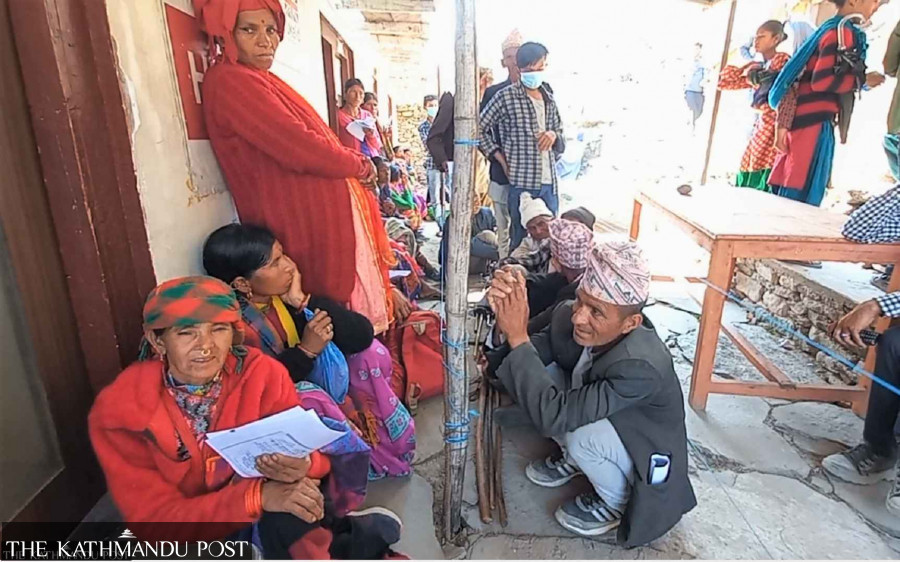National
Government’s liabilities soar amid declining revenue
Successive governments have been burdening the economy with populist cash schemes.
Prithvi Man Shrestha
The Department of Customs collected just Rs24.71 billion in revenue until January 9 in the month of Paush (mid-December 2022 to mid-January 2023) against the month’s target of Rs58 billion, suggesting a clear struggle of the government in meeting its revenue target.
The situation of revenue collection appears to be worsening as the government feels the pressure to arrange resources to finance the growing administrative and development expenditures. “We were supposed to collect around Rs2 billion a day, but to date this month [Paush], we have been able to collect just Rs1 billion a day,” said Punya Bikram Khadka, information officer at the Department of Customs. “We fear we would only be able to collect 50 percent of the target this month, compared to around 60 percent in the previous five months of the current fiscal year 2022-23.”
The current fiscal year began in mid-July 2022. Since then, the department collected Rs157 billion in revenue against the target of Rs257 billion until mid-December, according to the department. The collection of these five months accounts for only 61 percent of the target.
The country was already seeing a visible decline in revenue growth since Covid-19 hit the country. Despite this, the government had set an ambitious revenue target for the current fiscal year although it was already clear that meeting the target would be difficult.
The government was forced to make a downward revision in revenue collection targets in fiscal years 2019-20, 2020-21 and 2021-22 through mid-term reviews of the annual budget.
The credit-fueled imports in the early months of the fiscal 2021-22 contributed to the depletion in foreign exchange reserves, forcing the government to impose a complete ban on the import of several items from April 2022, and the ban continued on vehicles, high-end mobile phone sets and foreign alcohol products until mid-December last year.
The country is heavily reliant on imports for revenue with the customs revenue contributing nearly half of the total revenue. On the other hand, the shortage of loanable funds commonly known as the liquidity crunch in the banking sector from the early months of the last fiscal year has also been affecting economic activities. The slump in economic activities also affected revenue collection, say officials.
Despite a clear indication of possible difficulties in revenue collection, the government announced a number of populist programmes, including raising the salary of government staff by 15 percent, and lowering the eligibility age for receiving elderly allowance to 68 years from 70 years.
Likewise, a “pension programme” for farmers, under which the government would contribute 10 percent of farmers’ total deposits to the programme, was also announced.
The increase in salaries and lowering of the eligibility age for the elderly allowance is expected to create an additional liability of around Rs76 billion in the current fiscal year alone, according to the Finance Ministry.
The government has allocated Rs440.43 billion for salaries, pension and social security for the current fiscal year, up from Rs364.44 billion in the last fiscal year.
The cost of salaries and allowances for government employees and office bearers this year would rise by more than Rs44 billion, according to the budget document for the current fiscal year.
The government will have to spend more than Rs10 billion to pay pensions to retired government employees, including civil servants, police and army personnel, and teachers, according to the Pension Management Office.
Whenever the salary of the government staff rises, the government has to give a raise by an equivalent percentage to the retired staff too. “An estimated Rs77 billion will have to be spent on pensions in the current fiscal year, up from around Rs66 billion in the last fiscal year,” said Rajbhai Shrestha, information officer at the Pension Management Office.
For distributing social security allowances this year, the government has allocated Rs105.70 billion, which is an increase of Rs 17 billion from last year’s estimate, according to the planned expenditure details, known as the ‘Red Book’, published by the Finance Ministry.
In fact, the lowering of the eligibility age for elderly allowance has already created a financial burden of Rs5.46 billion in the first quarter of the current fiscal year as 113,911 new beneficiaries were added, according to the Department of National ID and Civil Registration, which deals with with with the social security allowance.
The number of beneficiaries is expected to rise to more than 200,000 by the end of the current fiscal year, increasing the costs by more than Rs7 billion, according to officials of the department.
“In fact, the revenue target was kept artificially high because of the fresh liabilities created by the government, although it was clear from the very beginning meeting the target would not be easy,” said former finance secretary Rameshore Khanal. “Now, despite the low revenue collection, the government cannot compromise on compulsory liabilities.”
He said the current economic problems arose because of the mishandling of the economy by former finance minister Janardan Sharma. “Had the interest rates been allowed to rise in the last fiscal year, which would lead to self-correction in imports, the country’s foreign exchange reserves would not have worsened and there would be no need to impose restrictions on imports,” said Khanal, adding that the import restriction as well the incapable political and administrative leadership at the Finance Ministry were responsible for the fallen revenue.
Last year, the then minister Sharma gave public speeches that the interest rate would be kept at a single digit.
While import restrictions affected the customs revenue, sluggish economic activities inside the country affected inland revenue. The private sector has said that there has been a slump in demand, which forced them to run their factories at lower-than-normal capacities.
“Except for factories related to FMCG [Fast Moving Consumer Goods] and foodgrain, production in all other manufacturing units have come down by 50-70 percent,” Shekhar Golchha, president of the Federation of Nepalese Chambers of Commerce and Industry told the Post in late November. The Nepal Electricity Authority also reported a reduced power consumption from the industrial sector, indicating sluggish economic activities.
On the other hand, the government’s expenditure, particularly the capital expenditure, has remained poor. “As construction activities slowed because of low capital spending, taxes to be paid by the construction sector also decreased,” said Rabi Singh, president of the Federation of Contractors’ Association of Nepal.
According to the Inland Revenue Department (IRD), it could collect only Rs150 billion as of mid-December against the target of Rs174.37 billion, which accounts for nearly 87 percent of the target.
“Dismal economic activity is one of the reasons behind the poor collection of inland revenue,” said Raju Prasad Pyakurel, information officer at the IRD.
Consequently, the government is now facing a resource crunch even to meet its recurring expenditure. According to the Financial Comptroller General Office (FCGO), the government’s revenue collection as of January 7 stood at Rs371.53 billion, while its recurrent expenditure stood at Rs422.96 billion.
Despite creating these added liabilities, the previous government, in its budget for the current fiscal year announced to reduce the government’s administrative expenditure by 15 per cent.
In fact, the size of the recurrent budget allocated for the current fiscal year was higher than that of the previous year. Recurrent budget for this fiscal year stands at Rs753.40 billion, which accounts for 42 percent of the total budget. In the previous fiscal year 2021-22, the recurrent budget was Rs677.99 billion, which was 41.52 percent of the total budget.
Due to a tendency of governments to create long-term liabilities, the recurrent expenditure has kept rising every year. Rising liability, sluggish economic activities and reduced imports have brought about a mismatch between resources and expenditure.
At a time when the government has been struggling to collect revenue, there is a competition among political parties to create long-term liabilities for the country, by announcing populist programmes, one after another.
Also, the Common Minimum Programme unveiled by the ruling parties on Monday promises to provide, for free, up to 10,000 litres of drinking water per family per month, 30 and 50 units of electricity per household per month, during the dry and wet seasons, respectively. The programme has also promised a raise in the monthly social security allowance, and plans to increase the number of social security allowance beneficiaries to 6 million in five years from the existing 3.57 million
“Governments over the years have been announcing freebies contributing to an increase in the state’s liabilities, just to take a political mileage over the opposition parties,” said Pushkar Bajaracharya, an economist. “Adding liabilities for the state, despite the dropping revenue, is an example of sheer irresponsibility of political parties.”




 18.12°C Kathmandu
18.12°C Kathmandu


.jpg&w=200&height=120)












